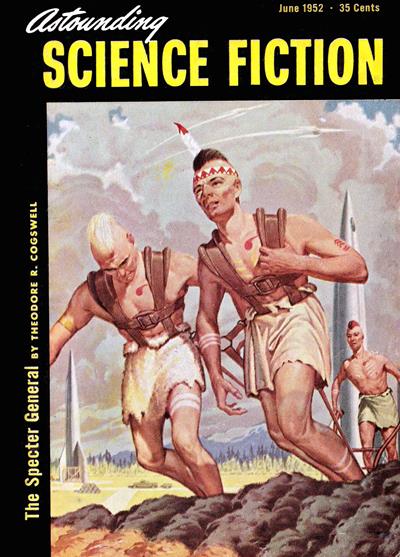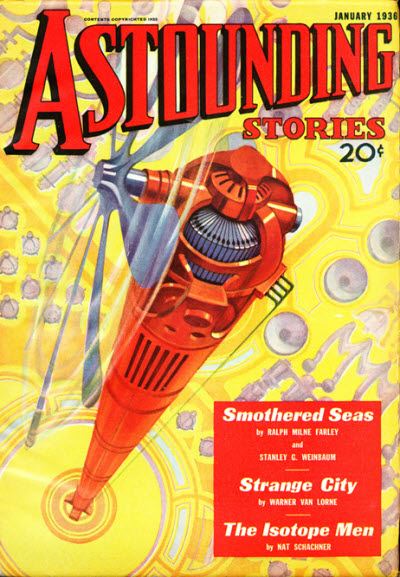
Part of Series
Vol 28, No 6. Contents: 6 • Supernova Centaurus • [Editorial (Astounding)] • essay by John W. Campbell, Jr. [as by The Editor] 9 • There Shall Be Darkness • novelette by C. L. Moore 35 • The Analytical Laboratory: December 1941 (Astounding, February 1942) • [The Analytical Laboratory] • essay by The Editor 35 • In Times to Come (Astounding, February 1942) • [In Times to Come (Astounding)] • essay by The Editor 36 • The Sorcerer of Rhiannon • novelette by Leigh Brackett 49 • The Rebels • [Kilkenny Cats] • novelette by L. Ron Hubbard [as by Kurt von Rachen] 62 • The Long-Tailed Huns (Part 2 of 2) • essay by L. Sprague de Camp 68 • Starting Point • novelette by Raymond F. Jones 80 • Medusa • novelette by Theodore Sturgeon 91 • Brass Tacks (Astounding, February 1942) • [Brass Tacks] • essay by The Editor 92 • Letter (Astounding, February 1942) • essay by Paul Spencer [as by Paul H. Spencer] 93 • Second Stage Lensmen (Part 4 of 4) • [Lensman • 5] • serial by Edward E. Smith [as by E. E. Smith, Ph.D.] 129 • If Seeing's Believing— • essay by uncredited. 【 PREVIOUS ISSUE ← February 1942 → NEXT ISSUE 】
Authors



Theodore Sturgeon (1918–1985) is considered one of the godfathers of contemporary science fiction and dark fantasy. The author of numerous acclaimed short stories and novels, among them the classics More Than Human, Venus Plus X, and To Marry Medusa, Sturgeon also wrote for television and holds among his credits two episodes of the original 1960s Star Trek series, for which he created the Vulcan mating ritual and the expression “Live long and prosper.” He is also credited as the inspiration for Kurt Vonnegut’s recurring fictional character Kilgore Trout. Sturgeon is the recipient of the Hugo Award, the Nebula Award, and the International Fantasy Award. In 2000, he was posthumously honored with a World Fantasy Award for Life Achievement.
Raymond Fisher Jones (November 15, 1915, Salt Lake City, Utah - January 24, 1994, Sandy, Salt Lake County, Utah) was an American science fiction author. He is best known for his 1952 novel, This Island Earth, which was adapted into the 1955 film This Island Earth and for the short story "The Children's Room", which was adapted for television as Episode Two of the ABC network show Tales of Tomorrow, first aired on February 29, 1952. Jones' career was at its peak during the 1940s, 1950s, and 1960s. His stories were published mainly in magazines such as Thrilling Wonder Stories, Astounding Stories, and Galaxy. His short story Noise Level is known as one of his best works. His short story "The Alien Machine", first published in the June, 1949 Thrilling Wonder Stories, was later expanded into the novel This Island Earth, along with two other short stories, "The Shroud of Secrecy", and "The Greater Conflict", known as The Peace Engineers Trilogy, featuring the character Cal Meacham. Jones also wrote the story upon which the episode "The Children's Room" was based for the television program Tales of Tomorrow in 1952.

Leigh Brackett was born on December 7, 1915 in Los Angeles, and raised near Santa Monica. Having spent her youth as an athletic tom-boy - playing volleyball and reading stories by Edgar Rice Burroughs and H Rider Haggard - she began writing fantastic adventures of her own. Several of these early efforts were read by Henry Kuttner, who critiqued her stories and introduced her to the SF personalities then living in California, including Robert Heinlein, Julius Schwartz, Jack Williamson, Edmond Hamilton - and another aspiring writer, Ray Bradbury. In 1944, based on the hard-boiled dialogue in her first novel, No Good From a Corpse, producer/director Howard Hawks hired Brackett to collaborate with William Faulkner on the screenplay of Raymond Chandler's The Big Sleep. Brackett maintained an on-again/off-again relationship with Hollywood for the remainder of her life. Between writing screenplays for such films as Rio Bravo, El Dorado, Hatari!, and The Long Goodbye, she produced novels such as the classic The Long Tomorrow (1955) and the Spur Award-winning Western, Follow the Free Wind (1963). Brackett married Edmond Hamilton on New Year's Eve in 1946, and the couple maintained homes in the high-desert of California and the rural farmland of Kinsman, Ohio. Just weeks before her death on March 17, 1978, she turned in the first draft screenplay for The Empire Strikes Back and the film was posthumously dedicated to her.

Lafayette Ronald Hubbard With 19 New York Times bestsellers and more than 350 million copies of his works in circulation, L. Ron Hubbard is among the most enduring and widely read authors of our time. As a leading light of American Pulp Fiction through the 1930s and '40s, he is further among the most influential authors of the modern age. Indeed, from Ray Bradbury to Stephen King, there is scarcely a master of imaginative tales who has not paid tribute to L. Ron Hubbard. Then too, of course, there is all L. Ron Hubbard represents as the Founder of Dianetics and Scientology and thus the only major religion born in the 20th century. While, as such, he presents the culmination of science and spiritual technology as embodied in the religion of Scientology. For an in-depth look at his life, visit www.LRonHubbard.org


